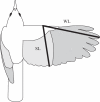High dispersal ability inhibits speciation in a continental radiation of passerine birds
- PMID: 22090382
- PMCID: PMC3282344
- DOI: 10.1098/rspb.2011.1922
High dispersal ability inhibits speciation in a continental radiation of passerine birds
Abstract
Dispersal can stimulate speciation by facilitating geographical expansion across barriers or inhibit speciation by maintaining gene flow among populations. Therefore, the relationship between dispersal ability and speciation rates can be positive or negative. Furthermore, an 'intermediate dispersal' model that combines positive and negative effects predicts a unimodal relationship between dispersal and diversification. Because both dispersal ability and speciation rates are difficult to quantify, empirical evidence for the relationship between dispersal and diversification remains scarce. Using a surrogate for flight performance and a species-level DNA-based phylogeny of a large South American bird radiation (the Furnariidae), we found that lineages with higher dispersal ability experienced lower speciation rates. We propose that the degree of fragmentation or permeability of the geographical setting together with the intermediate dispersal model are crucial in reconciling previous, often contradictory findings regarding the relationship between dispersal and diversification.
Figures





References
-
- Slatkin M. 1987. Gene flow and the geographic structure of natural populations. Science 236, 787–79210.1126/science.3576198 (doi:10.1126/science.3576198) - DOI - DOI - PubMed
-
- Bohonak A. J. 1999. Dispersal, gene flow, and population structure. Q. Rev. Biol. 74, 21.10.1086/392950 (doi:10.1086/392950) - DOI - DOI - PubMed
-
- Nichols J. D., Clobert J., Danchin E., Dhondt A. A. 2001. Dispersal. New York, NY: Oxford University Press
-
- Lomolino M. V., Riddle B. R., Brown J. H. 2001. Biogeography. Sunderland, MA: Sinauer Associates
-
- Gaston K. J. 2003. The structure and dynamics of geographic ranges. Oxford, UK: Oxford University Press
Publication types
MeSH terms
LinkOut - more resources
Full Text Sources

